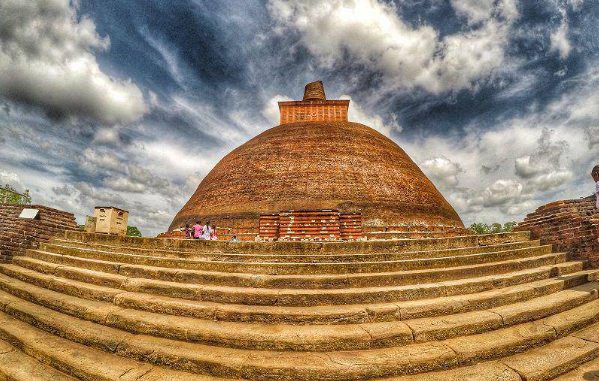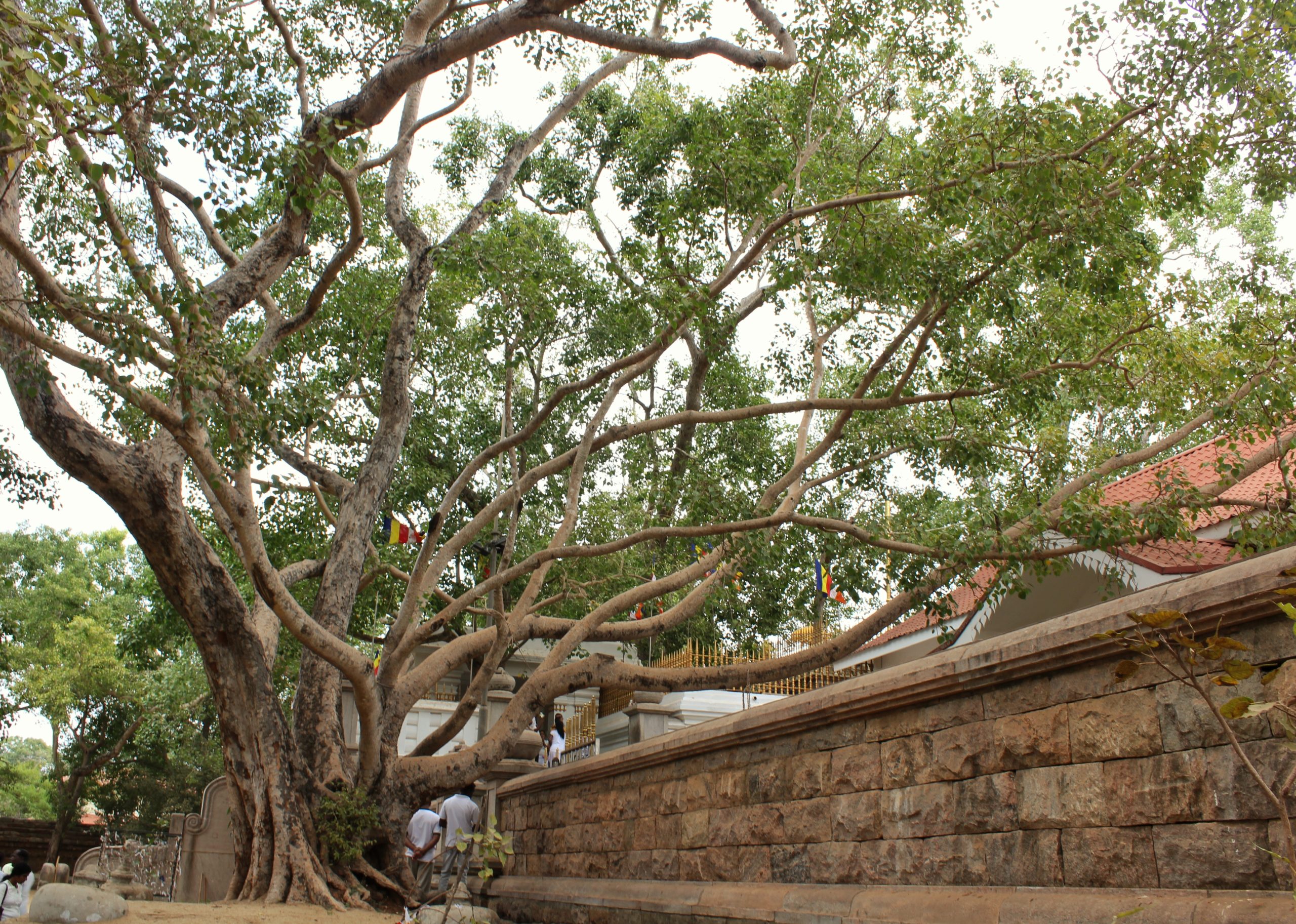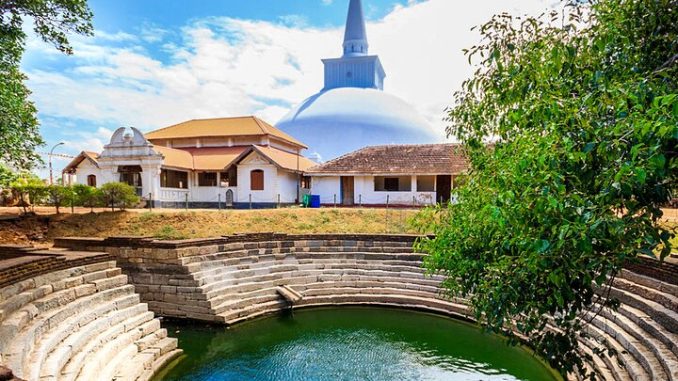
I was not particularly fond of my name, Anuradha. After meeting many other people with this name, this name seemed even more common to me. The importance of my name came to light when I got information about the world’s oldest city, Anuradhapura, located in Sri Lanka. The name of this holy place based on the name of a minister named Anuradha also gave me an opportunity to feel proud. And since then I decided to visit this beautiful city.
I started my solo road trip to UNESCO World Heritage Sites in Sri Lanka from Anuradhapura, after landing in Colombo. Left ‘Habarna Cinnamon Lodge’ early in the morning and reached Anuradhapuri around 7.30 am. My first glimpse of the sacred Anuradhapura, located behind a huge pond, was two huge stupas appearing behind the many birds flying over the pond. The first stupa is clean, white, and well-maintained, and the second stupa located nearby is made of typical, ancient, baked red bricks with a slightly broken top. I stopped there for a few moments looking at the clean birds flying in front of these two. She kept looking at this scene mesmerized. This scene further strengthened my desire to visit Anuradhapura.
Within a few minutes, my car reached the remains of an ancient Buddhist monastery. As soon as I set foot on the sacred land of Anuradhapuri, the glory of the millions of Buddhist monks praying here filled my heart with emotion. From here we moved towards the ancient stone stairs to see the white stupa located behind the pond.
READ ALSO: An exciting travel story of Ramayana related places in Sri Lanka
Ruwanweli Seya or Ruwanweli Dagba
At the entrance of this white stupa called Ruvanveli Dagba, the protector statue of Nagaraja made of stone was installed. I saw this type of protector statue in many places in Anuradhapura. While visiting the stupa, I noticed that, unlike the colorful clothes of the tourists, all the local visitors were wearing white clothes. According to my visitor, wearing white clothes is not mandatory here. This is the personal choice of local visitors. Probably the visitors are still following this tradition which started due to some reason.
The white dagba surrounded by white clouds seemed as if it had actually descended from the clouds. There were innumerable statues of Gajashishas on its outer walls. Within this new structure, similar ancient broken walls still exist around the stupa. I roamed around this stupa for some time. The joy of seeing the devotees dressed in white and holding incense and flowers in an atmosphere filled with devotion was supreme. Some devotees were sitting in meditation in front of the stupa.
It was built by Maharaja Datta Gamini in the 2nd century BC. Built in 1000 AD, this holy place of Theravada or Heinous Buddhism has other names like Mahastupa, Swarnamali Chaitya, Suvarnamali Mahasati, Ratnamali Dagba, etc.
Karthikeya, Vishnu, and other statues
The first statue that caught my attention was the life-size statue of the Maharaja, with folded hands in gratitude, gazing at the stupa. There were images of Buddha inscribed inside the cells located below the four Vrattakhandas in four directions. Inside a small temple located nearby, a colorful huge picture of Buddha was being worshiped in the form of Mahaparinirvana. One unique thing that was reflected here and in many other places was the pictures of Hindu deities Vishnu and Kartikeya placed on either side of the picture of Buddha. Along with the future Buddha Maitreya, many ancient stone replicas of the Buddha were also kept in great preservation. It is said that in ancient times, there was a big ruby on the top of this white stupa.
While roaming around the stupa, the local visitors were offering flowers, milk, and incense sticks as well as many herbs to the Ruwanveli Dagba.
Here my attention was drawn to a picture story in which the scene of the construction of this huge stupa was depicted. The labor donation given by the then Maharaja in the construction of this stupa was also clearly shown in it.
Sri Mahabodhi Tree – Anuradhapura
Seeing the huge Peepal tree of Anuradhapura, the words ‘Bodhi tree’ spontaneously came out of his mouth. Hearing this, my visitor addressed him with great reverence as ‘Shri Mahabodhi’. These expressions of his are indicative of the importance of this tree in Sri Lanka. As we know, the Buddhist nun Sanghamitra, daughter of Emperor Ashoka, planted a branch of the Bodhi tree, native to Bodh Gaya , Bihar , in Sri Lanka, which is still growing there today.

245 BC This tree, which was born from the branch of the Bodhi tree planted in 1755, was originally called ‘Jai Shri Mahabodhi’. Although the original Bodhi tree located in Bodh Gaya, Bihar is currently destroyed, its descendant is still alive in Anuradhapura, Sri Lanka. The new Bodhi tree at Bodh Gaya has been revived by a branch of this Mahabodhi tree in Anuradhapura. This means that this art of growing trees was known even at that time. According to my visitor, this art was used in tree transfer.
Holy place
Due to it being considered the most sacred place in Sri Lanka, ample arrangements have been made to protect the Mahabodhi tree. Only its upper part is visible from the wall built around it. I was told that botanists check their health twice a day. The original branch of the tree, brought from India, has been protected by golden plates. The platform on which this Bodhi tree is installed is surrounded by a golden fence. Despite the soil being sandy under the Bodhi tree and at other places in Anuradhapura, trees are flourishing here.
To see the Mahabodhi tree, we reached inside its courtyard by carved stone stairs. Elaborate statues of Chandrakant and Nagaraj Rakshak were installed on both sides of the stairs. Flower vendors were selling colorful lotuses. It was very interesting for me to see the petals of the buds artfully opening and giving them the shape of a flower.
The Mahavihar Museum located near the Mahabodhi tree looked very colonial. However, due to closure, we could not observe its collection.
Loh prasadaya or lovmahapaya
Located between Mahabodhi and Ruvanveli Seya in Anuradhapura, Lowamahapaya is an ancient palace. Because of the copper roof, it is also called Copper Palace or Loh Prasadaya. According to the literature, 6 years were spent in the construction of this building with 9 floors and 1600 pillars. But after 15 years it was destroyed in a massive fire. At present, only the remains of 1600 pillars of the original structure remain. A small building has now been constructed in place of the palace.
It is said that about 100 monks used to reside in Lovmahapaya to take care of the Bodhi Tree. Perhaps this Bodhi tree, capable of protecting itself, did not need his care.
Archaeological Museum
The Archaeological Museum of Anuradhapura or Puravidu Bhavan is one of the many archaeological museums in Sri Lanka. It is located inside the court building, between Loha Prasadaya and Ruvanveli Seya. Inside this museum, ancient artifacts found during the excavation of ancient sites of Sri Lanka are displayed. The Buddha statues, inscriptions, paintings, puppets, coins, jewelry, and many other objects displayed here introduce you to ancient Anuradhapura.
Jetwanramya Dagba
3rd. This huge stupa, built in the century, was the second largest structure after the pyramids of Egypt. Pictures before and after its restoration are displayed in the Archaeological Museum.
Near this stupa, there is a huge temple, though smaller than the Dagba. Inside it, there is a picture of Lord Buddha in Mahaparinirvana posture. Like other temples in Sri Lanka, here too yellow and red colors predominate in the colorful images of Buddha. While circling the stupa I saw replicas of serpents which are still worshipped. Two huge stone inscriptions were telling the story of this stupa.
I was feeling insignificant in the company of this huge stupa. Its vastness was making my ego feel that I was an insignificant part of this huge universe.
In front of the Dagba were the remains of an idol house. Inside its central chamber, there was a square Yantragalla on top of a circular platform, on top of which the statue of Buddha was once situated.
Kuttam Pokuna
Kottam Pokuna meaning twin ponds are two ponds made of stone. These beautiful ponds located nearby are like stepwells located in some states of India, but are relatively smaller. A beautiful shape of a snake has been carved on one of its walls. Regarding the rationale of the two ponds, I started speculating that they might have been made for hot and cold water or men and women.

These ponds are part of the water management process of Anuradhapura. There are many water filtration chambers near the pond, which are used to receive water from the water supply canal of Anuradhapura, drain it respectively, and provide water to these ponds through underground drains. Seeing these ponds reminded me of the water collection and distribution system located in the Kanheri caves of Mumbai.
After getting information about these ponds from the National Museum of Colombo, I was very eager to visit them. But I was saddened to see these ponds filled with contaminated, muddy water and discarded plastic bottles.
Buddha in Samadhi
Samadhi means the highest state of meditation where the seeker becomes so engrossed in the meditation of the goal that he is not even aware of his own existence. In most of the statues of Buddha, he is reflected in this meditation posture.
Another specialty of this meditating statue of Buddha is that when viewed from three different directions, his three different expressions are reflected. They are peace, joy, and kindness.
Abhaygiri Vihar
Like Jetavanramya, this stupa made of bricks is also one of the largest stupas of Anuradhapura. Despite being basically a Jain monastery, it is known as the largest monastery of Buddhism, capable of housing 5000 monks. This is the same monastery where the monks first accepted the sacred tooth of Buddha in Sri Lanka.
While circling this stupa, we also saw a beautiful statue of Buddha holding an umbrella. Like many stone temples of India, here too a chess platform has been carved on the stones.
Thuparama and Mirisveti Stupa
White, clean, and beautifully maintained, tall stone pillars stand around these two stupas. Looking at them, their ancient grandeur can be estimated. These stupas, once situated under the canopy, still appear very attractive.
Actually, Anuradhapura is full of many small and big stupas. You will get tired after seeing them but the line of stupas will not end.
Anuradhapura city tour
While visiting Anuradhapura city, you will see the remains of many monasteries and residences. Most of the ancient structures remain only in the form of bases and pillars made of stone and bricks. These are in such a broken state that it is not easy to imagine them in their original form.

Seeing these, one cannot believe that at one time thousands of Buddhist monks lived here. And they used to study, chant and pray here. However, their original vastness can definitely be estimated from these remains.
Chandrakant and Raksha statues visible everywhere seem to bind this city with an invisible thread.
There are many small and big museums located in Anuradhapura. The remains of statues found during excavation are displayed here. You can visit these museums full of rich archives with a single ticket.
Isurumuniya Stone Temple
Inside this temple situated on the outskirts of Anuradhapura, two beautiful ponds filled with lotuses were grandly welcoming us. Inside, in the middle of a beautiful pond, there were two huge boulders piercing the flat earth. An attractive garden was built around this pond.
The temple was situated on top of a rock. We climbed the second boulder with the help of stairs and a bridge. A panoramic view of Sri Lanka was visible from here. The lush green fields in the background of the hills looked very attractive. On top of that, the nearby lotus pond and garden also looked amazing.
The most famous statues of Isurumuniya are the statue of a couple and the statue of Gaj, built on top of the boulder located near the pond.
Suddenly my eyes fell on some girls nearby. She was trying to connect the two boulders with wooden planks. Although imaginary, his happiness over his efforts was clearly visible on his face. Seeing them reminded me of my childhood.
Mihintale – the starting point of Buddhism in Sri Lanka
As part of the next leg of my journey, I am 11km from Anuradhapura. Reached a distant hill. This hill is important from historical point of view, Mihintale. It was here that Sanghamitra and brother Mahindra first met the then-king of Sri Lanka. 247 BC This meeting, which took place in 1777, proved to be a milestone for the beginning of Buddhism in Sri Lanka.
There was a need to climb a hill to reach the said site. The stairs made by cutting the hill were very easy. But my efforts in the hot afternoon had left me very tired.
This visit of mine to Anuradhapura is special for me. The day I entered Anuradhapura was the full moon day of June. Many centuries ago, on this full moon day, Mahendra had also set foot on the land of Anuradhapura. I got a sign from God. And I climbed the hill. The panoramic view of Anuradhapura from here was very beautiful. This is a suitable place to see sunrise and sunset. However, if there is not much faith then visiting this place can be avoided.
Brief History of Anuradhapura
According to the Mahavamsa, the oldest literature of Sri Lanka, Anuradhapura was founded in the 5th century. century BC Was declared the first capital of Sri Lanka. However, archaeological literature has dated Anuradhapura to the 10th century. century BC The city of has been certified. Its concept and structure were done by King Pandukabhaya. 3rd. century BC During the reign of King Devampiya Tissa, its prosperity doubled by day and quadrupled by night. It was during this time that Buddhism made its debut in Sri Lanka.
King Tissa had conceptualized this city very minutely. He built a system of many canals and ponds for agriculture. Some of these are still in use.
Anuradhapura faced many attacks over time. Still 11E. Till then this city continued to move forward on the path of progress. Thereafter Polonnaruwa was made the capital of Sri Lanka. I will soon present before you the story of Polonnaruwa.
Anuradhapura remained invisible for many centuries. But its memory did not fade away in the psyche of the Sinhalese. Year 19th During the excavations done by the British in the century, the lost Anuradhapura was regained by the Sinhalese and the whole world.
Some tips for visiting Anuradhapura
- The sacred city of Anuradhapura is a UNESCO World Heritage Site. There is no darshan fee for Sri Lankan residents. The entry fee for other visitors is $25.
- Time is limited to visit the museum. All other places can be visited at any time.
- There is no habitable place available in ancient Anuradhapura. However, there are many facilities available for living in the new Anuradhapura. I had arranged for my stay in Habarna, located about 1 hour away from Anuradhapura.
- There is no special arrangement for food here, only some refreshments, tea and coconut water are available.
- There are many shops selling souvenirs but I did not find anything specific related to this place. Most of the shops had the same items available that are sold at any tourist destination in the country.
- Bicycle is the best means to visit Anuradhapura.
- Photography is permitted at all venues except museums.